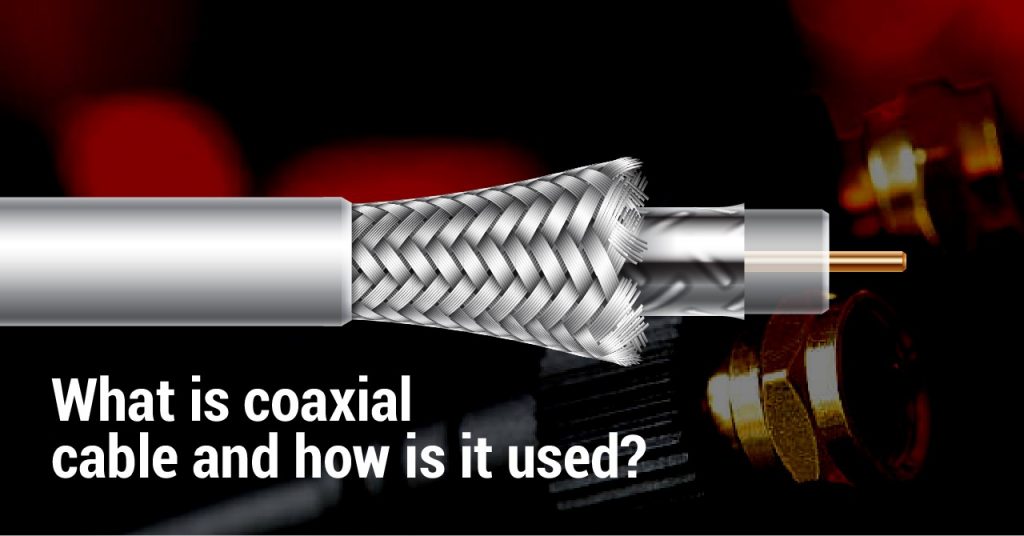


06
Jun
In today’s global age of technology, everything depends on the use of the internet. Whether you are trying to place an order on your favorite food delivery service application or business, try to reach out to clients for corporate orders.
As the global requirement for efficient, reliable, and fastest data transmission, the world quickly uses coaxial cables.
But have you ever wondered what coaxial cables are and how they are used? Well, Don’t worry. We will tell you exactly that in this article, so just continue reading till the end.
Coaxial cables are mostly used by cable operators, telephone companies, and internet service providers to transfer data, video, and voice communications to customers worldwide.
Coaxial cables started in the early 20th century and are preferred for reliable and accurate transmission. However, it has disadvantages that have caused it to be replaced by either fiber optic cable, category cable, or wireless signals.
Coaxial cable’s shielded design contributed immensely to its success. This design allows the cable’s copper core to transfer data fast, without surrendering to interference or damage from various environmental factors.
The coaxial cable’s inner conductor is surrounded by an insulating layer covered with conductive shielding. Some coaxial cables also have an insulating outer jacket.
The following diagram shows the construction of a typical coaxial cable.

Coaxial cable’s center conductor ability to transmit data instantly while remaining safe from damage and interference has contributed to its popularity.
Coaxial cables carry the data in the center conductor, while the layers surrounding the conductor try to stop any signal loss or attenuation loss and reduce electromagnetic interference.
The first layer of the dielectric layer offers distance between the core conductor and the outer layers while providing some insulation.
The next layers, collectively called the shield, keep electrical impulses and radio transmissions out.
There are two main types of coaxial cables. The first type has an impedance of 75 Ohm (Ω) and the second impedance of 50 Ohm. Impedance is the measure of resistance in the cable to the flow of electrical energy.
57 Ohm cables are usually used for transmitting video signals, while 50 Ohm cables are used for data and wireless communications.
Let’s look at some of the types of coaxial cables:
These cables have larger conductor’s dielectric insulation, and are made from a different kind of shielding material. They offer better signal quality and effectively handle GHZ level signals.
These cables have even thinner conductors than the RG-6 cables and are perfect for short and low-frequency transmissions.
These cables are easily identifiable as they are thicker than other types of cables. It is ideal for transmitting data at longer distances since it has a lower attenuation level than RG-6 or RG-59
Usually, coaxial cables are used to transmit radio frequency signals.
Its other applications or uses include transmission lines connecting radio transmitters and receivers to their antennas, computer network connections, digital audio, and distribution of cable television signals.
Let’s look at some of the most common uses of coaxial cables and the type of coaxial cable used for them.
A poor-quality coaxial cable can easily impact your TV reception, so you must select the best cable for this job.
For this purpose, the RG-6 coaxial cable of 75 Ohm is ideal at an affordable price as well.
For high-definition TV broadcasts, the best coaxial cable is RG-11. It offers a higher gauge which offers more space for signals to transfers.
At a cost-effective coaxial cable price, RG-11 will deliver strong HD signals at high speeds for you.
Internet signals are transmitted and received at a higher frequency than traditional analog video.
RG-6 coaxial cable was developed to satisfy this requirement. Not only does it have a large conductor for better signal quality, but its dielectric insulation is also thicker.
These coaxial cables can also carry GHZ level signals more effectively as they are made with a different kind of shielding material.
RG-6 can be used for longer distances than RG-59 without worrying about video signal loss, but it isn’t as convenient to work with since it is thicker.
One of the main advantages of using coaxial cable is that the electromagnetic field responsible for carrying the signal exists only in the space between the inner and outer conductors in an ideal coaxial cable.
This ability allows coaxial cables to be installed near metal objects without worrying about power losses. These cables also offer protection of signals from any external electromagnetic interference.
While both of these types of cables can be used to transmit and receive video, audio, and another form of data, they offer distinct advantages and disadvantages.
Let’s break down the difference between these two types of cables based on reliability, speed, and cost.
Coaxial cable’s insulated structure protects it from most environmental factors, but it is still not immune to outages. Its ability to perform is also dependent on the volume of concurrent users.
Fiber cables are not sensitive to outages, and their overall performance isn’t affected by the number of concurrent users.
Coaxial cables’ uploading and downloading speeds aren’t similar. Even though these speeds are lower than fiber, they are adequate for smaller businesses.
Fiber cables offer symmetric speeds faster than coaxial cables, making them ideal for larger businesses with high volume usages.
Coaxial cables are easy to install, and their implementation is relatively cheap because it’s widely available. Various internet and television networks bundle services are also available to maximize your savings.
Fiber cables are expensive due to activation and installation fees. Since the installation process can be comprehensive, your other system and networks operations may be impacted.
Are you looking for the best coaxial cables for your business available at an economical and fair coaxial cable price?
Don’t worry. You can find the most budget-friendly and cost-effective coaxial cable price in Pakistan only at Pakistan cables eStore. Your decision can vary depending on the business situation, location, budget, and bandwidth requirement.